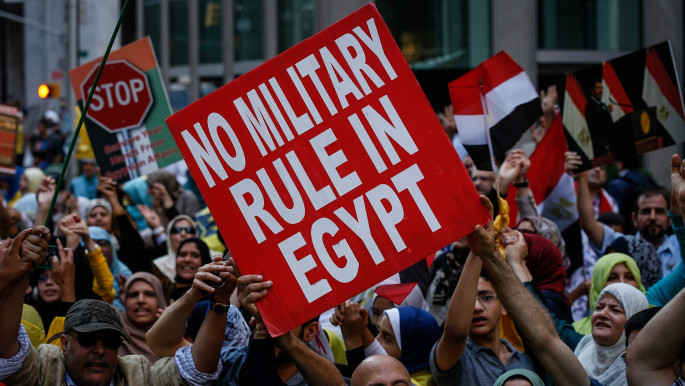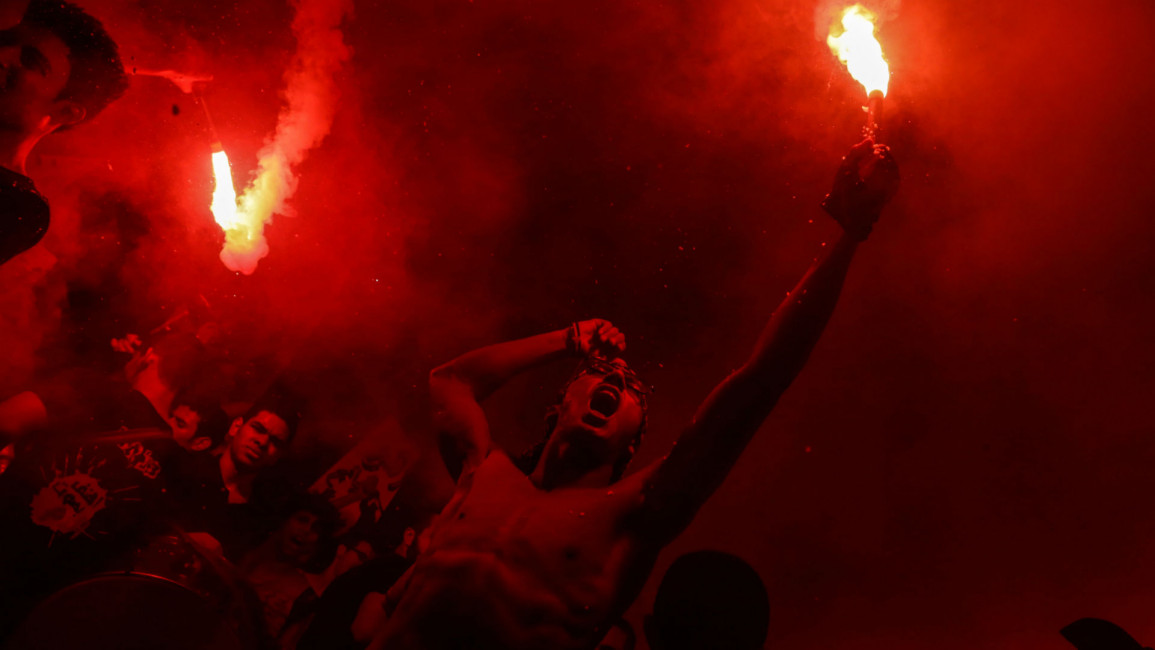
When peaceful revolutions meet violent regimes
Since the wave of revolutions that engulfed the Arab world in early 2011, the Middle East has been going through seemingly endless turmoil.
The uprisings were followed by wars in four countries, creating millions of refugees and attracting thousands of foreign fighters, posing a serious threat to world security.
Amid such uproar, it is easy to forget what caused all of the trouble in the first place.
Peaceful revolutions
The Arab Spring was a peaceful drive for democracy and human rights. The revolutions, which spread to five Arab countries - Tunisia, Egypt, Yemen, Libya, and Syria - were attempts to end decades of autocratic and oppressive rule in the Middle East.
They were led by the youth, women, civil society organisations and educated elites, inspired by dreams of a better way of life. They were spontaneous, triggered by decades of suppression and the political opening caused by the Tunisian uprising.
In Tunisia, the military refused to open fire on protesters - forcing President Zine El Abidine Ben Ali to flee to Saudi Arabia after a short uprising. People throughout the Middle East became emboldened to protest.
The Egyptian uprising followed, giving the world another example of a great peaceful revolution. For three weeks, millions of Egyptians rallied peacefully in the streets across the country, rejecting regime attempts to spread chaos and violence.
 |
|
| Egypt's revolution was met with counter-revolution, and the 'deep state' never lost its grip on power [Getty] |
At least 800 civilians were killed by the security forces, yet the masses stayed largely peaceful.
In Yemen, protests were led by students and female activists despite a very tribal and conservative society. For weeks, students protested peacefully calling on the regime to step down.
Still, on a single Friday, March 18 2011, regime forces hunted down 52 students and peaceful protesters who were organising a sit-in in Sanaa. The massacre accelerated the pace of defections inside the regime, pushing tribal and military leaders to side with the revolution and to call on President Ali Abdullah Saleh to step down.
Both the Libyan and Syrian revolutions were initially peaceful.
They were triggered by young people and educated elites hoping for democratic and open societies. But, the militaristic nature of the Libyan and Syrian regimes pushed the revolutions in the wrong direction. The massive crackdown by the Gaddafi regime on protesters, using heavy military weapons and foreign militias forced Western powers to quickly intervene and arm Libyan citizens in order to save the population.
In Syria, the revolutions stayed peaceful for months, despite the massive crackdown by the regime and its draconian security state. However, after a bloody assault on the Baba Amr neighbouhood in the city of Homs, killing hundreds in February 2012, 11 months after the start of the uprising, many felt they had no choice but to take up arms to defend themselves.
Violent regimes
In the five countries, peaceful protesters faced security regimes led by military men and supported by oppressive regional powers. The Tunisian president may have stayed in power if his military leaders agreed to kill revolutionaries.
In Egypt, the Mubarak regime employed police, the military, and ordinary thugs to crack down on peaceful protesters - killing hundreds and arresting thousands. Even after Mubarak stepped down, massive violence was used to end numerous protests triggered by the revolution.
The military leaders who took charge of the country after Mubarak closed down foreign and civil society organisations, killed dozens of youths and peaceful protesters, conducted virginity tests on female activists, and used torture on regular, systemic basis.
This was all in order to break the will of protesters and to stop any further demands for meaningful reform. Even after the election of Mohamed Morsi, Egypt's first civilian presidents, the security abuses did not strop.
In July 2013, the military overthrow the elected president in a coup that triggered an unprecedented wave of state-sponsored violence that left many hundreds dead and tens of thousands jailed in sham trials.
 |
When the revolution came to Tripoli, and world powers backed the revolutionaries, it became difficult to restore the power of the central state after decades of Gaddafi rule |  |
The Gaddafi regime had always weakened his country's military hierarchy fearing the possibility of a coup against him. Instead, he supported a strange mix of local security forces, tribal leaders, and foreign militias.
Therefore, when the revolution came to Tripoli, and world powers backed the revolutionaries, it became difficult to restore the power of the central state after decades of Gaddafi rule and the systematic destruction of civil society and independent state institutions.
When you lead a country for decades based on the will of one strong man, it is difficult to build state institutions capable of holding the country together in his absence.
A very similar situation prevailed in Yemen, where Ali Abdullah Saleh used clan and tribal influence to circumvent the power of state institutions. Under Saleh's rule, state institutions were weakened in favour of tribal leaders and security institutions led by Saleh's family.
Therefore, the military was divided by the uprising and it was not possible to convince Saleh to step down without heavy Gulf and foreign pressure. Still, after leaving power in 2012, major segments of the security institutions stayed loyal to Saleh - enabling him and his new Houthi allies in Summer 2014 to militarily overthrow the government of President Abd Rabbuh Mansur Hadi, who was largely supported by the revolutionaries.
In Syria, the regime used massive violence to crack down on peaceful protests and the civilian population alike. The military shelled peaceful rallies. Tanks and aircraft were used to attack residential areas. Foreign militias and Russian airpower were invited by the regime to fight his own people.
As a result, one the world's worst modern humanitarian crises were created, with hundreds of thousands killed and millions fleeing and seeking refuge around the world.
The violent crackdown on the peaceful revolutions was not only conducted by national regimes. Very often, it was supported by regional powers. In Bahrain, Gulf countries sent military forces to back the ruling regime against Shia protests. The majority of the Gulf countries also sided against the Egyptian and Yemeni revolutions.
Iran, meanwhile, supported the Syrian regime and the Houthi militias in Yemen. Israel sided against the Arab Spring as a whole, fearing the empowerment of the Arab masses. Western powers watched as violent regimes liquidated protesters and closed down civil society organisations.
Once the dust began to settle, they were also quick to conduct business-as-usual with oppressive and counter-revolutionary regimes such as Sisi's in Egypt.
Violence as a way of life
Violence employed by oppressive regimes is more than a tactic. It is a way of life embedded at so many levels of power politics. State media openly spread hatred against revolutionaries and democracy advocates. Lies, xenophobic, propaganda, and brainwashing are systematically used.
 |
The recourse to state violence is also often protected by legislation |  |
Massive power is used to crack down on political opposition - the Syrian regime is a clear example. The recourse to state violence is also often protected by legislation. The Sisi regime in Egypt was keen to expand the power of military courts in a new constitution.
Independent media and civil society organisations are systematically destroyed. Torture and inhumane jail conditions are prevalent across the Middle East.
Under such conditions, people are taught that violence is the only language spoken by politics. The citizenry is left without any political process or political leaders who could offer an alternate perspective. Jail, torture, and the methodical, precise destruction of political opposition open the doors for the likes of the Islamic State group while exiling, jailing, or killing young, educated, and peaceful activists.
The Arab Spring was an historic opportunity for peace, democracy, and human rights in the Middle East. But it was met with a massive and violent crackdown by militaristic regimes and their regional allies, as Western powers stood by and watched.
And in the middle of a massive counter-revolutionary wave of violence purposefully engineered by ruling regimes to block any prospects for democracy, it is crucial to remember how we reached this point.
Alaa Bayoumi is an Egyptian journalist and the author of two books studying US foreign policy in the Middle East. He also writes on democratic transition in the Arab world.
Follow him on Twitter: @Alaabayoumi
Opinions expressed in this article remain those of the author and do not necessarily represent those of The New Arab, its editorial board or staff.




